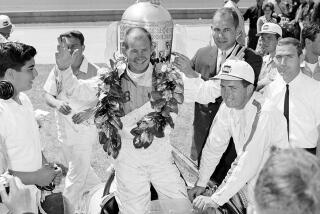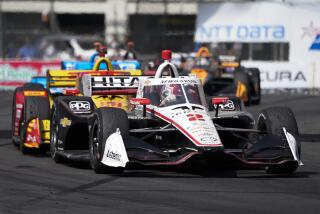Even His Career Was a Fast One
- Share via
He was, as one longtime associate put it, “a race driver’s race driver.” He was the last guy in the world you’d want to see in your rear-view mirror with the race on the line and two laps to go.
His name went into the language. Every wife in the country would turn to her husband as he was driving too fast down the freeway and observe, “All right, Parnelli, you can slow it down now. You qualified!”
It was estimated that he moved a car up two laps just by being in it. He drove in seven Indianapolis 500s. He won one, should have won two more. He was on the pole twice and never started farther back than the second row. He was almost the last guy to win without extensive factory or corporate support.
He used to go back to the Speedway with automotive cayuses known affectionately as “Ol’ 98” or “Calhoun.” They were front-engine roadsters that weren’t exactly held together by glue and baling wire but neither were they the computerized marvels Roger Penske puts on the track today.
His mentor was the late J.C. Agajanian, an improbable character who made his money in garbage and who showed up at the Speedway in a ten-gallon hat with a rattlesnake band on it, a diamond stickpin and reptile boots.
Rufus Parnell Jones was probably as good an athlete as ever sat behind the wheel of a race car. He was fearless but not foolish. He was daring but not desperate. He had eyes like a cat and the reflexes of a crouched lion. He could see the whole track at a glance.
It was just about impossible for him to go slow. In the 1962 race at Indy, he lost his brakes with 50 laps to go, and his crew had to stop his car coming into the pits by throwing tires in front of it. He didn’t win the race but he finished it. In fact, he finished four of the seven races he drove there. He caught fire in one, lost a wheel bearing in one and had a bearing fail in a third.
He was the first to go over 150 m.p.h. at the Speedway. He won the pole and the race in 1963. He was second in 1965 and, to all intents and purposes, had the 1967 race won in a revolutionary turbine car when, three laps from a coasting finish, a $6.98 bearing burned out--taking about $600,000 with it.
And then, he walked away from it.
No one cold believe it. It was as if Mike Tyson announced his retirement over the fallen body of Frank Bruno, Magic Johnson hung it up after a playoff. In all of sports history, only one other man, also a Jones--Bobby--had ever quit at the height of his powers in this way.
People thought it was a grandstand stunt. Parnelli was only 34 years old. Parnelli would be back. An Indy 500 at the time without Parnelli Jones was as unthinkable as a U.S. Open without Jack Nicklaus. Parnelli was a part of auto racing lore, the kind of driver they made movies about. How could he park the Offy and go away and leave the game to A.J. Foyt, the Unsers, the foreigners? It was un-American.
That was 22 years ago. I had lunch with Parnelli Jones the other day. The flat fighter’s face is still the same. The eyes still take in everything without glasses. The stomach is flat. He still looks as if he belongs on the pole.
Parnelli did not give up racing altogether. He drove the occasional off-road race, a few Trans-Ams. But he never stepped into an Indy car again after 1967. Why?
“It was a combination of things,” he said. “The danger? I don’t think so. You learn to live with the danger. Danger is exciting. You know, people who live with danger tend to appreciate the other things in life more. They see how quickly it can all be taken away.
“I think it was more that I was winning that 1967 race so ridiculously easy--yet I did not really savor the feeling. My first win was like the highest moment of my entire life. I couldn’t sleep the night I won. This time, it was like, ‘Well, I’ve done this before.’ ”
Was the fact that he lost the race so shatteringly a factor in his decision?
“Well, I’ll tell you: the race had been called by rain after 18 laps. It was re-started the next day with the parade lap, pace lap and all the warmups. That bearing quit with only three laps to go and I figured, without those extra re-start laps, it would have held together for the checkered flag.”
Had the turbine won, would he have remained in racing?
“I suppose. I would have been defending my championship. But I was anxious to get on with my business career. Agajanian and my partner, Val Miletich, had put me in real estate deals. I had my tire business. I stayed in racing. I just didn’t stay in a car.”
Did he miss the adulation? Wasn’t 34 too early to become a part of the past?
Parnelli laughs. “I was speeding on the Pomona Freeway once and a cop stops me. He comes up to the car and he says ‘Who do you think you are--Parnelli Jones?’ I had to admit, that was a boot.”
He recalls that he “stayed in just enough racing to keep the guys respecting me. They couldn’t be sure I wouldn’t return in a fast car. Nobody was ever quite sure he could write me off.”
Parnelli, who got his nickname when a friend fixed him a fake I.D. under the name Parnelli Jones so he could race when he was only 16 years old, resisted the lure of the track even though contemporaries Foyt and Al Unser still tee it up at the Brickyard in or near their 50s.
Parnelli will be on the track at Long Beach this month but not in the Grand Prix. He will drive in the Toyota Pro-Celebrity Race on Saturday, April 15, the day before the main event.
Parnelli will take the wheel against a field of disc jockeys, running backs (Walter Payton), anchor men, movie stars and the sons of race drivers. One of these will be Parnelli Jones’ son, P.J.
The race is 10 laps or about 190 fewer than Parnelli was used to, and it will be 16.70 miles, 484 fewer than his rides of more than 20 years ago.
The pros have to give the celebrity drivers a 30-second head start, which means they will get to see one of the most terrorizing sights on a race track--Parnelli Jones in their rear-view mirrors. Not to worry. He won’t be there long. As the Indy racers of the ‘60s could tell you, pretty soon they’ll be in his.
More to Read
Go beyond the scoreboard
Get the latest on L.A.'s teams in the daily Sports Report newsletter.
You may occasionally receive promotional content from the Los Angeles Times.










